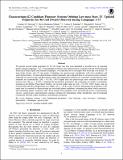Characterizing K2 Candidate Planetary Systems Orbiting Low-mass Stars. IV. Updated Properties for 86 Cool Dwarfs Observed during Campaigns 1–17
Author(s)
Dressing, Courtney D; Hardegree-Ullman, Kevin; Schlieder, Joshua E; Newton, Elisabeth R; Vanderburg, Andrew; Feinstein, Adina D; Duvvuri, Girish M; Arnold, Lauren; Bristow, Makennah; Thackeray, Beverly; Abrahams, Ellianna Schwab; Ciardi, David R; Crossfield, Ian Jm; Yu, Liang; Martinez, Arturo O; Christiansen, Jessie L; Crepp, Justin R; Isaacson, Howard; ... Show more Show less
DownloadPublished version (4.086Mb)
Publisher Policy
Publisher Policy
Article is made available in accordance with the publisher's policy and may be subject to US copyright law. Please refer to the publisher's site for terms of use.
Terms of use
Metadata
Show full item recordAbstract
© 2019. The American Astronomical Society. All rights reserved. We present revised stellar properties for 172 K2 target stars that were identified as possible hosts of transiting planets during Campaigns 1-17. Using medium-resolution near-infrared spectra acquired with the NASA Infrared Telescope Facility/SpeX and Palomar/TripleSpec, we found that 86 of our targets were bona fide cool dwarfs, 74 were hotter dwarfs, and 12 were giants. Combining our spectroscopic metallicities with Gaia parallaxes and archival photometry, we derived photometric stellar parameters and compared them to our spectroscopic estimates. Although our spectroscopic and photometric radius and temperature estimates are consistent, our photometric mass estimates are systematically ΔM ∗ = 0.11 M o (34%) higher than our spectroscopic mass estimates for the least massive stars (M ∗,phot < 0.4 M o). Adopting the photometric parameters and comparing our results to parameters reported in the Ecliptic Plane Input Catalog, our revised stellar radii are ΔR ∗ = 0.15 R o (40%) larger, and our revised stellar effective temperatures are roughly ΔT eff = 65 K cooler. Correctly determining the properties of K2 target stars is essential for characterizing any associated planet candidates, estimating the planet search sensitivity, and calculating planet occurrence rates. Even though Gaia parallaxes have increased the power of photometric surveys, spectroscopic characterization remains essential for determining stellar metallicities and investigating correlations between stellar metallicity and planetary properties.
Date issued
2019-07Department
Massachusetts Institute of Technology. Department of Physics; MIT Kavli Institute for Astrophysics and Space ResearchJournal
Astronomical Journal
Publisher
American Astronomical Society